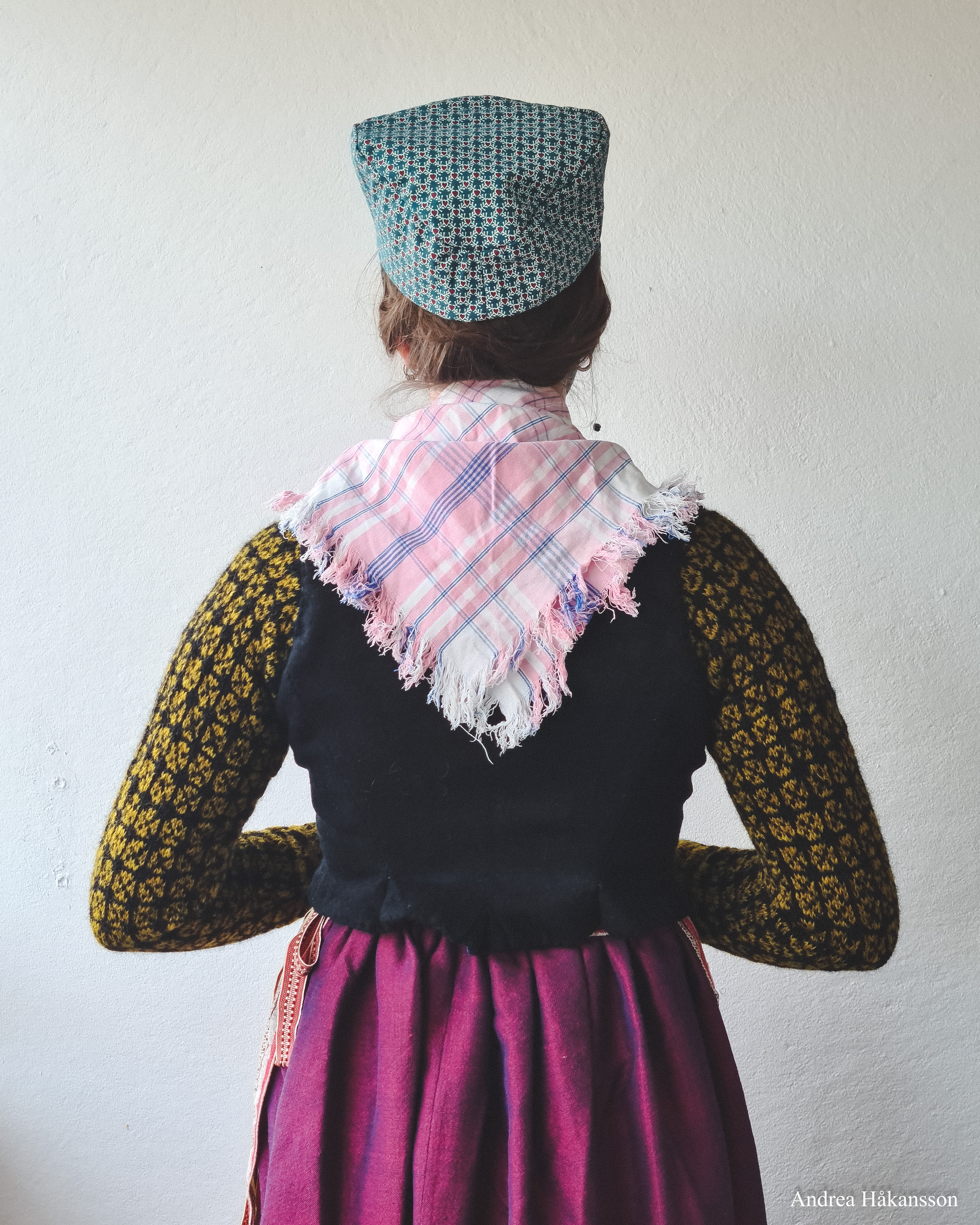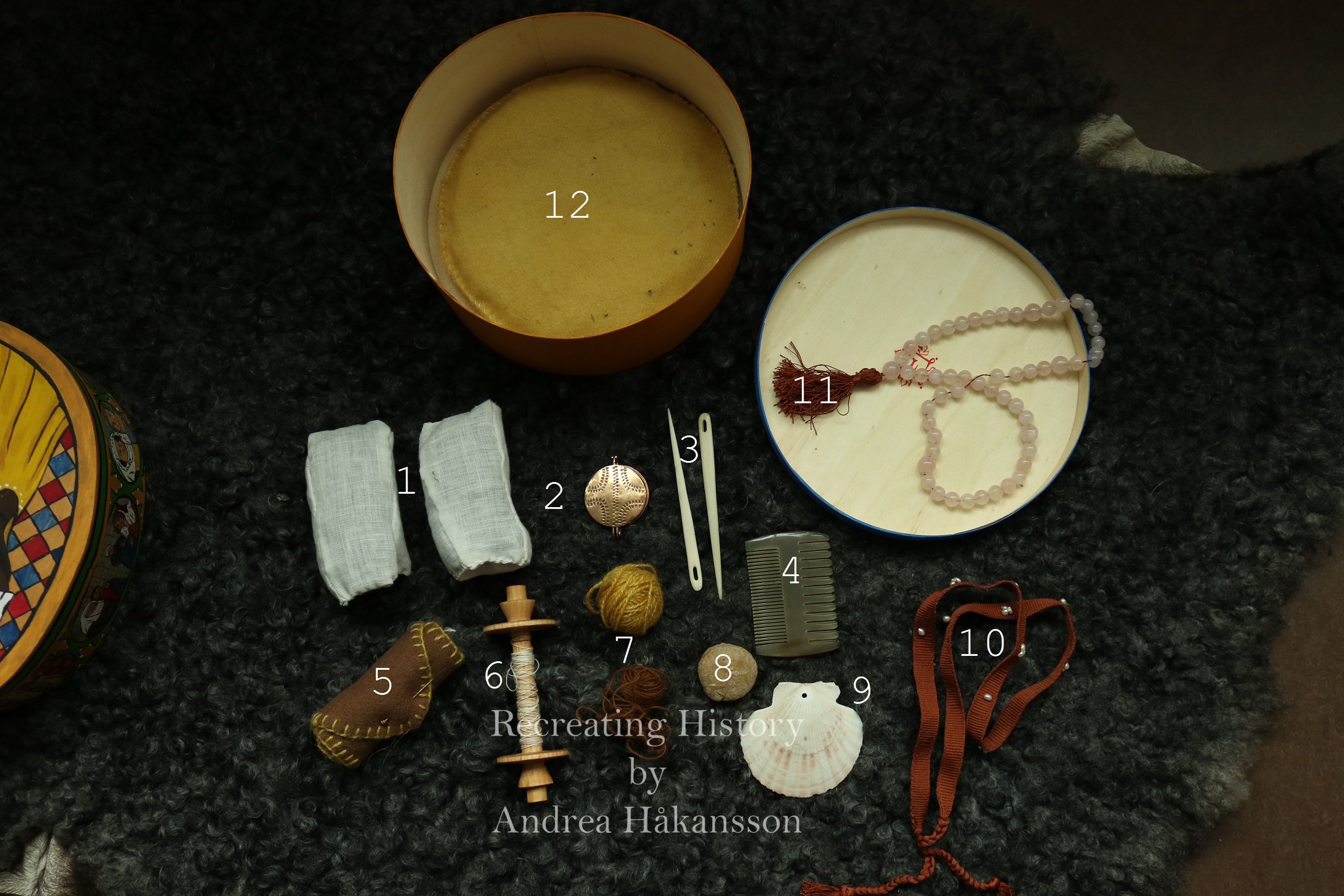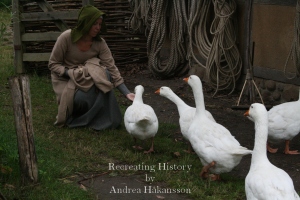Jag känner ett par stycken som säger att de känner sig som allra finast när de har på sig sina medeltidskläder. Till en början kanske man inte tycker det, men det finns en inlärningskurva så att säga.. Anledningen till det är att medeltidsidealen inte är helt kompatibla med våra moderna ideal. Jag personligen känner mig väldigt fin och vacker när jag kör på med ordentliga 1300-talsflätor och slöja, dok och hela biddevitten, men jag vet att många tycker att just det är det svåraste med medeltidsstassen. Jag skulle nog säga att jag utvecklat två olika set med skönhetsstandarder. Oftast säger de inte emot varandra, men när de gör det är det mest de moderna idealen som inkräktar på medeltidsidealen.
I know several people that have said that they’ve never felt as beautiful as when they’ve been wearing their medieval clothes. It is a learning curve, though, since the medieval standards and ideals aren’t really compatible with our modern ones. 14th century braids and the whole package with veil and wimple makes most people cringe at first, but I feel really pretty when I wear my hair in the styles of the late 14th century. I would say that I have developed two sets of beauty standards. One modern and one medieval. Mostly they don’t contradict each other, but when they do it’s mostly the modern ideals that intrude on the medieval ones.
Mitt största problem (okej, det är väl inget problem egentligen, och jag gillar mitt ansikte, men vi kallar det ett problem ändå) är solbränna. Jag blir ganska lätt solbränd, åtminstone för att vara skandinav. Jag spenderar dessutom ganska mycket tid utomhus, både i skolan och på min fritid, vilket leder till att jag redan nu är ordentligt solbränd, framförallt i ansiktet. Kolla bara på fotot nedan från Battle of Wisby 2013. Kamerablixten gör saken värre, men man ser att jag är ordentligt brun i ansiktet, åtminstone för att vara skandinav som sagt.
My major problem (ok, it’s not really a problem, and I like my face, but we’ll call it a problem anyway) is sun tan. I tan quite easily, for being Scandinavian, and spend a lot of time outside, both in school and on my free time. That means that my skin is tanned, and especially my face. Just look at this photo from Battle of Wisby 2013. The flash doesn’t help anybodys looks, but my face really stands out in terms of tan (at least for a typical Scandinavian I would say).

Det går bra när jag porträtterar lägre stånd, som den soldatfru jag gör ibland, men på senare tid har jag börjat porträttera rika kvinnor ur en högre samhällsklass (vilket ni antagligen vet) och då blir det ett problem. Ett litet problem, men ett problem ändock. Vit, blek hud var idealet – framförallt för fina damer som inte behövde vara ute på fältet. Åtminstone senare i tiden innebar solbränna att man var tvungen att vara utomhus för att arbeta, medan en blek hy signalerade att man hade tillräckligt mycket pengar för att låta andra göra jobbet åt en, och själv vara inne hela dagarna.
It works fine when I’m portraying lower social classes, like a soldiers wife or so, but later I’ve started to portray wealthy, higher social class, women as well (which you know I guess), and that’s where it starts to become a problem. A small problem, but a problem none the less. A white, pale, skin was the ideal – especially for those nice ladies that wouldn’t have to be out on the field all day. At least later in history a tan signalled that you had to be outside to work, whereas a pale skin showed that you were rich enough to be able to stay inside all day and let others do the work.
 |
| Field work – Les Très Riches Heures de Duc de Berry, June, 1412-1416 |
På senare tid har jag fått ytterligare ett problem som har med solbränna att göra och det är det egentliga problemet som fick mig att skriva det här inlägget. För ungefär en månad sen fick jag mitt första par glasögon. Jag är väldigt glad för det – inte bara för att jag numera ser bättre – utan också för att mitt moderna jag tycker om att se mig själv i spegeln med glasögonen. Jag spenderar dock fortfarande ordentligt med tid utomhus, och min solbränna har kommit precis som vanligt, men nu med ett nytt drag! Numera har jag en väldigt härlig glasögonbränna, vilken är väldigt tydlig när jag inte har glasögonen på mig – exempelvis på medeltidsevent. Det är något som direkt för tankarna till det moderna och anledningen till att den finns.
Lately, another problem concerning tan has developed, and that’s the main problem which caused me to write this post. About a month ago I got my first pair of glasses. I’m really happy about that, not only because they make my eyesight better, but also because my modern self enjoys the sight in the mirror of me in glasses. I’m still spending a lot of time outside, and my usual tan has arrived as it should, but with a new feature! These days I have tan lines after my glasses, which are very visible when I’m not wearing my glasses (e.g. at medieval events). That’s a dead give away that instantly brings the mind to thinking about what’s caused it, which then is something very modern.
Visst, det finns belägg för glasögon på 1300-talet, men det finns dels inget som direkt styrker teorin att kvinnor hade glasögon så vitt jag vet, och framför allt så ser de som fanns absolut inte ut som mina moderna glasögon och ger alltså inte i närheten av samma linjer i brännan.
Yes, of course there are evidence for glasses in the 14th century but there is not really anything to support the theory that women wore them, and above all – they did not look anything like my modern pair, and would therefore not yield the tan lines.
Så hur får man bukt med detta då? Ett recept i the Trotula, det medeltida kompendiet om kvinnomedicin, skriver följande:
So how do you battle this? A recipe from the Trotula, the medieval compendium on women’s medicine, states the following:
“An ointment for whitening the face. Take two ounces of the very best white lead, let them be ground; afterward let them be sifted through a cloth, and that wich remains in the cloth, let it be thrown out. Let it be mixed with rainwater and let it cook until the consumption of the water; (…) And when it is dried out and cooled, let rose water be added, and again boil it until it becomes hard and thick, so that from it very small pills can be formed. And when you wish to be anointed, take one pill and liquefy it in the hand with water and then rub it well on the face, so that the face will be dried. Then let it be washed with pure water, and this [whitened look] will last for eight days.” The Trotula, see full source below.
White lead är ett blykarbonat, vilket vi nuförtiden inte gärna skulle ha på huden eftersom bly är giftigt. Inget för mig alltså.
White lead is a lead carbonate, which we nowadays would hesitate to put on our skin because of the toxicity of lead. Not a recipe for me then.
Så, vad ska jag göra nu då, för att tillfredsställa mitt medeltidsjag? Mitt nästa event kommer vara redan i helgen på Ekenäs Riddarspel, vilket innebär att jag har ganska lite tid att bestämma mig för hur jag vill göra. Planen just nu är att köpa någon slags färgad hudkräm eller foundation/concealer som är lätt och inte riktigt syns, mer än att det jämnar ut mina ljusa partier mot det mörkare, solbrända. För tillfället får det gå an att jag har ett solbränt ansikte till mina fina kläder. Efter helgens event har jag en månad på mig att fixa en annan lösning innan det är dags för nästa. I månadsskiftet juni/juli åker jag med Carnis till danska Middelaldercentrets 25-årsjubileum.
Now, what should I do to make medieval me happy? My next event will be this weekend at Ekenäs Riddarspel which means that I have little time to decide. The plan at the moment is to buy some kind of tanned lotion or perhaps a foundation/concealer or so that is light (as opposite to heavy) and won’t really be seen, to cover up my light, untanned parts of the face. For now I will have to live with a tanned face to my fancy clothing. Then I have a month to figure out a better solution for my problem before the next event at the 25 year anniversary at the Medieval Centre in Denmark.
Det kommer bli svårt att hitta en riktigt bra lösning tror jag, och det kommer krävas mycket tankeverksamhet. Vilket alternativ är bäst? Att använda modernt smink för att få en korrekt medeltida look, eller gå utan smink och visa en felaktig bild? Normalt när man ställs inför de frågorna inom andra delar av återskapandet brukar man välja att inte ta med eller använda det som är problematiskt. Åtminstone jag gör så. Det blir dock svårare i det här fallet eftersom man inte kan välja att inte ta med sitt ansikte. Det sitter liksom fast i en. Är användandet av modernt smink försvarbart ur en historisk synpunkt här? Gör användandet av modernt smink att resultatet blir mer korrekt än om man går utan? Många väldigt intressanta frågor, som ber om att bli diskuterade, väcks.
To find a good solution will be hard, atleast on the mind. Which alternative is more correct? To use modern make-up to achieve a proper medieval look, or go natural and have the wrong look? Normally when you have those two choises you choose to skip it. Or atleast I do. If you can’t present a correct piece then don’t, right? It’s harder when it comes to the face as it does here, since you can’t skip your face, you can’t leave it at home. Is the use of modern make-up justified here? Does the use of modern tools make the result more period? A lot of interesting questions begging for discussion arise.
Till sist – om du råkar vara på Ekenäs Slott i helgen så kom gärna förbi Carnis läger och säg hej! Jag tycker att det är väldigt trevligt att träffa er läsare på riktigt.
And if you happen to be at Ekenäs Castle this weekend, please come by the Carnis camp and say hello! I really like to meet you readers face to face.
 |
| At Ekenäs I will take a nice photo of a jacket that I’ve made for a friend, so stay tuned for the next post where you will see it!
|
Literature
Green, M. H. (2001). The trotula. A Medieval Compendium of Women’s Medicine.


















































































































































































